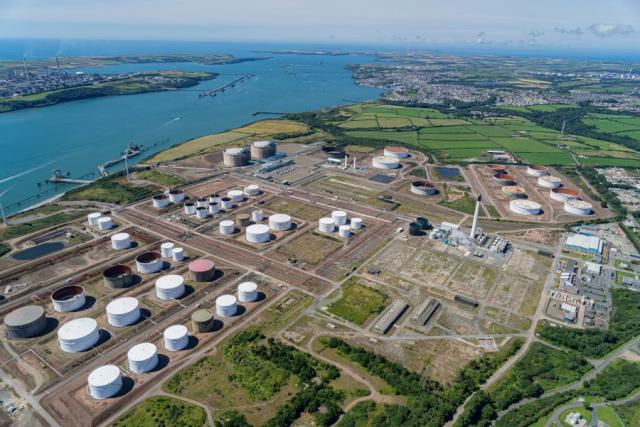
The Pembroke dock and and oil and gas terminals in Milford Haven, Wales, U.K. (Source: ShutterStock.com)
LONDON—California-based energy infrastructure company Sempra sees massive growth in global LNG trade and U.S. operating capacity over the next eight years, the company’s chairman and CEO Jeffrey W. Martin said at a recent industry event in England.
“We expect, [and] a lot of market watchers expect, [global LNG capacity to] grow by roughly 50% over the next eight years to something closer to 560 million tonnes per annum,” compared to roughly 380 million tonnes per annum (mtpa) at the end of 2021, Martin told attendees during the Energy Intelligence Forum in London last week. The executive admitted the forecast “might be a little bit short” owing to potential increased availability.
“What's interesting is the United States today has [more or less] 70 million tonnes per annum of operating capacity, and we project that over the next eight years that will grow by 130%,” Martin said.
U.S. LNG exports have become a hot commodity in Europe and Asia this year owing to a global supply crunch exacerbated by Moscow’s military offensive in Ukraine and subsequently reduced Russian energy exports amid heightened geopolitical tensions in the region.
RELATED
US Becomes World’s Second Largest LNG Exporter
Global LNG trade reached 372.3 million tonnes in 2021, up 4.5% compared to 2020 due as strong post-pandemic recovery produced a rise in LNG imports, the International Gas Union (IGU) revealed in July 2022 with publication of its 13th edition of the IGU World LNG Report.
Global liquefaction capacity reached 459.9 mtpa at the end of 2021, owing to about 6.9 mtpa that was brought online during the year while the average global utilization rate was 80.4% compared to 74.6% respectively.
Between January-April of 2022, an additional 12.5 mtpa of liquefaction capacity was brought online, bringing the total global liquefaction capacity to 472.4 mtpa as of April 2022, the London-based IGU said in the report.
In 2021, Australia was the world’s largest LNG exporter, shipping out 78.5 million tonnes. Qatar and the U.S. were the second and third largest exporters in that year, shipping out 77 million tonnes and 67 million tonnes, respectively. Russia was the fourth-largest LNG exporter with 29.6 million tonnes, according to the IGU.
In the later part of the North American summer, the U.S. surpassed Australia in terms of trade and liquefaction capacity, according to recent reports from the Washington-based Energy Information Administration (EIA), citing data from CEDIGAZ.
RELATED
Three US LNG Export Projects to Add 5.7 Bcf/d by 2025
Competitive U.S. advantage
Martin attributed the U.S.’ rapid rise to the top of the LNG food chain – total LNG exports and liquefaction capacity – to three “certain competitive advantages,” which he explained to the attendees at the annual event.
First, the U.S. has a 100 year supply of gas and currently produces about 100 Bcf/d, of which around 20% is destined for export as piped gas or LNG.
“About 7 Bcf/d goes to Mexico by pipeline gas, and almost 70% of that flows across Sempra’s system,” Martin said. “Another 12 Bcf/d-13 Bcf/d is exported to about 40 nations in the world.”
“And what's really beneficial is we can produce it at relatively low cost,” Martin added. “And in part, that's because 25% of that natural gas is associated gas. So as you increase oil production, one of the externalities of oil production is you're still getting a lot of natural gas out of the ground. So I think that gives us a benefit.”
Second, “the depth of our capital markets, the ability to access financing, rule of law, sanctity of contracts, having good engineering firms that can build export facilities,” the executive explained.
Third and finally, the U.S. has a prime geographic position.
This allows companies to source gas in Texas and export it from the North American west coast into the Pacific to arrive in Asia in 10 days, or source the same gas from other fields and export it out of the U.S. Gulf Coast, which is uniquely positioned for Europe, the executive said.
In terms of the U.S.’ competitive advantage, “it's a product of having the low cost and low price volatility, a unique position geographically in the world and having access to good construction resources and the financing to do it,” Martin concluded.
Recommended Reading
Lake Charles LNG Selects Technip Energies, KBR for Export Terminal
2024-09-20 - Lake Charles LNG has selected KTJV, the joint venture between Technip Energies and KBR, for the engineering, procurement, fabrication and construction of an LNG export terminal project on the Gulf Coast.
Entergy Picks Cresent Midstream to Develop $1B CCS for Gas-fired Power Plant
2024-09-20 - Crescent will work with SAMSUNG E&A and Honeywell on the project.
FERC Chair: DC Court ‘Erred’ by Vacating LNG Permits
2024-09-20 - Throwing out the permit for Williams’ operational REA project in the mid-Atlantic region was a mistake that could cost people “desperately” reliant on it, Chairman Willie Phillips said.
Diamondback to Sell $2.2B in Shares Held by Endeavor Stockholders
2024-09-20 - Diamondback Energy, which closed its $26 billion merger with Endeavor Energy Resources on Sept. 13, said the gross proceeds from the share’s sale will be approximately $2.2 billion.
Optimizing Direct Air Capture Similar to Recovering Spilled Wine
2024-09-20 - Direct air capture technologies are technically and financially challenging, but efforts are underway to change that.
Comments
Add new comment
This conversation is moderated according to Hart Energy community rules. Please read the rules before joining the discussion. If you’re experiencing any technical problems, please contact our customer care team.






